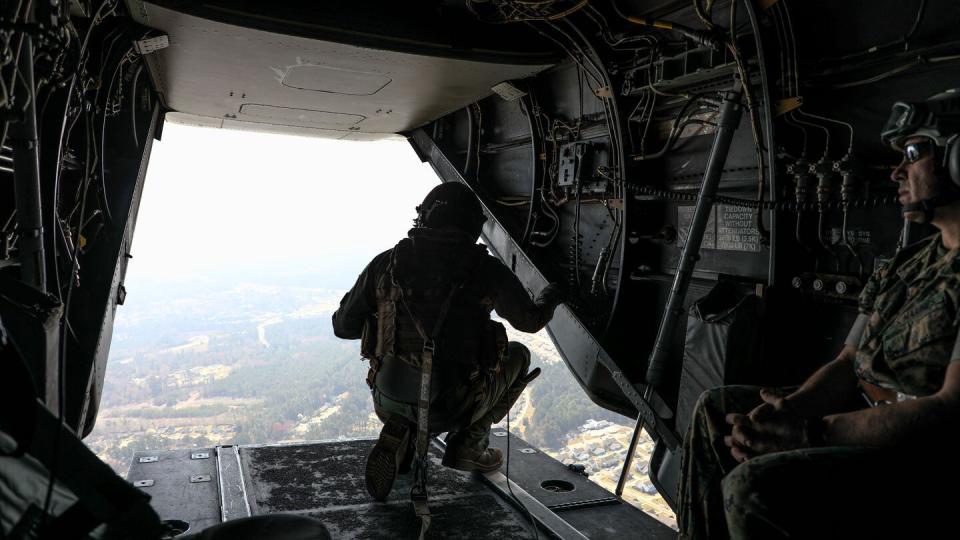V-22 Osprey could see second life, with new drive system, wings in 2050s
The V-22 program office is studying the future of the tiltrotor aircraft, weighing both a technology refresh as well as whether it could rip off the wings and nacelles to add decades of additional life to the airframes.
U.S. Marine Corps Col. Brian Taylor, the joint program manager for the aircraft, told an audience at the Modern Day Marine conference in Washington that the U.S. military is the only one flying a tiltrotor because it’s a complicated plane with a complicated drive system.
That said, Osprey operators continue to find “the mission sets the V-22 are getting into is absolutely unlimited” because the plane is so robust and flexible.
The program office is eyeing a V-22 Cockpit Technology Replacement, or VeCToR, upgrade effort that will begin research and development in 2026 and would be fielded from 2032 to 2042. That effort aims to bring more off-the-shelf technology to the screens, keyboards, computers and radars in the cockpit, for example.
The office is also in the early stages of studying a Renewed V-22 Aircraft Modernization Program, or ReVAMP, effort that would consider how to keep the fuselage for decades beyond what would otherwise be the end of the plane’s effective life in the early 2060s.
Research and development for the ReVAMP effort would formally begin in 2036, according to his briefing slides, and installations would take place in 2042 to 2050.
“If we had to do V-22 all over again, what would that look like? And really focusing on keeping the fuselage, and maybe you replace the wing and the nacelle, maybe you don’t,” he said during his presentation.
“Something we’re learning about the fuselage is that it is actually kind of life-unlimited, that there’s enough margin in it. And so if we put a new wing and a nacelle on there, we’re probably good for another 40 years,” he added. “So that is a study that’s ongoing, but it’s [all about] how you take this platform and make it available to the services” into the 2070s.
Taylor said the effort is in its infancy and that his office is soliciting ideas and input from industry to shape the effort.
Asked if a V-22 fuselage with new wings and drive system would continue carrying out transport missions or take on other work, Taylor said: “I don’t know, and that’s the fun part.”
Taylor added that the office is considering an optionally unmanned version while it looks at how to make the plane more reliable, maintainable, affordable and safe.
The drive system has been at the heart of several challenges for the platform. In February 2023, the program office halted operations for an undisclosed number of planes until their input quill assembly was replaced. This input quill assembly, which attaches the Osprey’s engine to its proprotor gear box, was causing hard clutch engagements in cases when the assembly was over a certain age.
Taylor said a new input quill assembly prototype that incorporates 15 design changes will be delivered in the next month or so to begin testing.
The proprotor gear box itself may also see changes in the near term, as it has seen reliability issues, including “chipping,” where metal shavings come off during routine operations and can damage the rest of the drive system. Taylor said the Navy is investing in a gear box upgrade for its CMV-22 planes.
Taylor said the idea was that the program office would work with industry to engineer a plan to extend V-22 fuselages for the next chapter of their service lives. That plan would then go to the Marine Corps, Navy and Air Force so they can decide if they want to spend their money on this life-extension plan or if technology is changing such that they’d rather pursue something entirely new to meet their mission needs.
“I’m a little bit biased; I would love to see the V-22 stay in service for the next 100 years. But if there’s a better thing that we need to pivot to, then that’s really kind of up to the services,” Taylor said.

On the VeCToR cockpit effort, Taylor said the program office is struggling to support displays that were developed in the 1980s.
“We are kind of at the tipping point where we are spending enough on just maintaining what we have, that it’s time to do something different,” he said. “Honestly, it was a keyboard that pushed me over the edge, the astonishing bill to keep the keyboard on the aircraft. It’s 26 letters, 10 numbers, maybe a couple other buttons, but it seems like there’s a smarter way to do this stuff.”
As the Marines undertake this effort, Taylor said he also wants to help the plane become more software-centric to allow for faster capability upgrades.

